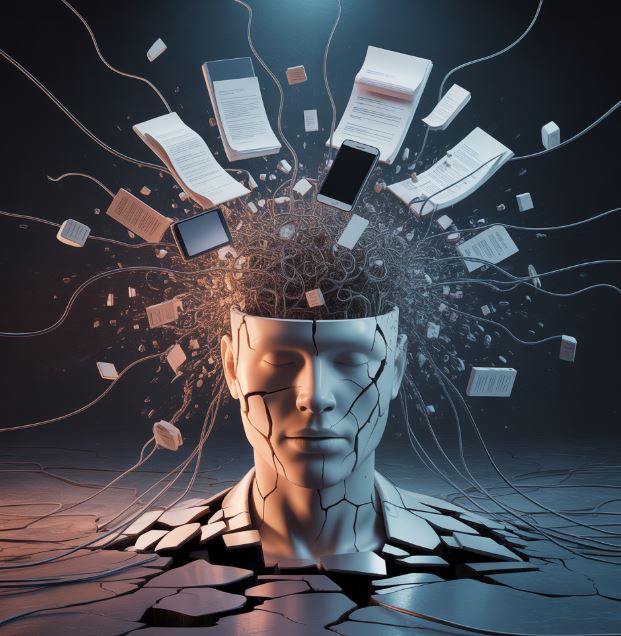Why Your Brain Feels Busy But Nothing Gets Done: The Mental Multitasking Trap
 You just spent 20 minutes writing one email but at the same time, your brain was also planning tonight’s dinner, rehearsing tomorrow’s presentation, and worrying about that thing you forgot to do last week. By the time you hit send, you had to reread the email three times to make sure it actually made sense.
You just spent 20 minutes writing one email but at the same time, your brain was also planning tonight’s dinner, rehearsing tomorrow’s presentation, and worrying about that thing you forgot to do last week. By the time you hit send, you had to reread the email three times to make sure it actually made sense.
You thought you were being incredibly efficient. Your brain felt busy and engaged, but you were actually doing everything poorly while feeling more scattered by the minute.
You sit down to focus on one task, but your mind immediately starts juggling six other concerns. You feel productive because your brain is working overtime, but at the end of the day, you can’t remember what you actually accomplished.
What Mental Multitasking Actually Looks Like
Mental multitasking isn’t doing multiple physical tasks at once, it’s having your attention split across multiple thought streams while your body sits perfectly still. You look completely focused to anyone watching, but inside your head, it’s chaos.
The Always-On Mental State
 Your brain has learned to run like a computer with 47 browser tabs open. Everything feels urgent and nothing feels finished. You’re constantly switching between mental tasks, and each switch costs you focus and energy.
Your brain has learned to run like a computer with 47 browser tabs open. Everything feels urgent and nothing feels finished. You’re constantly switching between mental tasks, and each switch costs you focus and energy.
Here’s what researchers at Stanford found: people who regularly multitask actually have less brain density in areas responsible for focus and emotional control. What that means is your brain literally changes structure when you make mental juggling your default mode.
Why Your Scattered Brain Feels So Productive
Mental multitasking creates a powerful illusion that your brain is busy, engaged, and processing multiple things simultaneously. It feels like you’re getting more done because you’re thinking about more things.
The Busy Brain Reward System
Every time you switch between thoughts or make progress on any mental task, your brain releases a small hit of dopamine. This creates a subtle addiction to the scattered mental state. It feels rewarding in the moment, even though you’re accomplishing less.
Think about how good it feels to mentally cross something off your list while doing something else. You’re in a meeting, but you just mentally planned your evening, you feel efficient and capable and your brain interprets this as success, even though you probably missed half the meeting.
The Control Illusion
Mental multitasking gives you the illusion that you’re staying on top of everything. By keeping multiple concerns active in your mind, you feel like you’re managing your life proactively and you’re not forgetting anything because you’re thinking about everything.
But this feeling of control comes at the cost of actually getting things done. When your attention is split, you’re not really managing anything well, you’re just maintaining awareness of multiple things without deeply engaging with any of them.
The Hidden Costs of Mental Juggling
While mental multitasking feels productive, it creates several hidden costs that compound over time and wreck your ability to think clearly.
The Attention Residue Effect
When you switch your mental attention from one task to another, part of your attention stays stuck on the previous task. Researchers call this “attention residue.” Even when you’re trying to focus on something new, part of your brain is still processing the previous concern.
This means you’re never giving any task your full mental capacity and you’re always working with diminished resources because part of your brain is still engaged with other thoughts.
The Decision Fatigue Explosion
 Every mental task you’re juggling requires ongoing micro-decisions. When to think about it, how much attention to give it, how to prioritize it against other thoughts. When you’re mentally multitasking, you’re not just making decisions about multiple tasks, you’re making decisions about how to manage your attention across all of them.
Every mental task you’re juggling requires ongoing micro-decisions. When to think about it, how much attention to give it, how to prioritize it against other thoughts. When you’re mentally multitasking, you’re not just making decisions about multiple tasks, you’re making decisions about how to manage your attention across all of them.
This multiplies decision fatigue exponentially. Instead of making decisions about one thing at a time, you’re constantly making decisions about how to allocate your mental resources.
The Clarity Erosion
Mental multitasking erodes your ability to think clearly about any individual issue. Complex problems require sustained, focused attention to fully understand and solve. When your attention is fragmented, you can only engage with the surface level of each concern.
I noticed this when I was trying to solve a work problem while mentally planning a vacation. Neither got my full creative attention. I ended up with a mediocre solution to the work issue and a vacation plan that forgot several important details. Both would have been better if I’d focused on them separately.
How to Recognize Your Mental Multitasking Patterns
Mental multitasking often becomes so automatic that you don’t notice when you’re doing it. Learning to recognize these patterns is the first step toward choosing more focused mental states.
The Background Worry Track
Pay attention to whether you have a constant background track of worries running while you’re trying to focus on specific tasks. This sounds like ongoing mental commentary about everything you need to do, should have done, or might need to do later.
You’re working on a presentation, but part of your mind is simultaneously running through your evening plans, tomorrow’s schedule, and that thing you forgot to do last week. The presentation gets done, but it takes longer and feels more stressful than it needs to.
The Mental List Management
 Notice if you’re constantly maintaining mental lists of tasks, concerns, or reminders while trying to focus on something else. This creates the feeling that you’re staying organized, but it actually divides your attention and makes both the main task and the list management less effective.
Notice if you’re constantly maintaining mental lists of tasks, concerns, or reminders while trying to focus on something else. This creates the feeling that you’re staying organized, but it actually divides your attention and makes both the main task and the list management less effective.
I used to mentally review my to-do list while having conversations with people. I thought I was being efficient, but I was actually being a poor listener and doing ineffective planning simultaneously.
The Future-Past Spiral
Mental multitasking often involves having part of your attention in the past (reviewing what happened, what you should have done differently) and part in the future (planning, worrying, anticipating) while trying to engage with present-moment tasks.
This creates a scattered, ungrounded feeling because you’re never fully present with what’s actually happening right now.
The Physical Toll of Mental Juggling
Mental multitasking doesn’t just affect your thinking, it creates measurable physical stress that compounds throughout the day.
The Cognitive Overload Stress Response
 When your brain is constantly juggling multiple mental tasks, it activates your stress response system, and your nervous system interprets the cognitive overload as a form of threat, which triggers the release of stress hormones like cortisol.
When your brain is constantly juggling multiple mental tasks, it activates your stress response system, and your nervous system interprets the cognitive overload as a form of threat, which triggers the release of stress hormones like cortisol.
This is why you can feel completely exhausted after a day of mental multitasking even if you didn’t do any physically demanding activities. Your brain has been working overtime to manage multiple attention streams, and that cognitive effort translates to physical fatigue.
The Sleep Disruption Connection
Mental multitasking often continues into the evening, making it difficult for your brain to wind down for sleep. If you’re used to having multiple thought streams running simultaneously during the day, your brain doesn’t automatically switch to single-focus mode when you try to sleep.
Many people who struggle with mental multitasking report that their minds race at bedtime, jumping between different concerns and making it difficult to fall asleep or stay asleep.
Building Single-Focus Mental Habits
The alternative to mental multitasking isn’t trying to think about nothing. It’s learning to direct your full attention to one thing at a time, even if that thing is planning or problem-solving.
The One-Thing Focus Practice
Choose one mental task and commit to giving it your complete attention for a specific period of time. This might be as short as five minutes for difficult tasks, or as long as an hour for engaging creative work.
During this time, when other thoughts arise (and they will), notice them without judgment and gently redirect your attention back to your chosen focus. This isn’t about having a perfectly quiet mind, it’s about choosing where to direct your mental energy.
The External Brain Approach
Instead of trying to mentally juggle multiple concerns, use external tools to hold information so your brain doesn’t have to. Keep a notebook or phone app where you can quickly jot down thoughts that arise while you’re focusing on something else.
This allows you to acknowledge other concerns without abandoning your current focus. You’re not ignoring important things, you’re just choosing when to think about them rather than trying to think about everything simultaneously.
Healthier alternative: Try the “capture and return” method. When a distracting thought arises during focused work, write it down immediately and tell yourself “I’ll think about this at 3 PM.” This satisfies your brain’s need to not forget important things while preserving your current focus.
To explore the cognitive impact of multitasking and why single-tasking improves focus, see this article from Verywell Mind: Single‑Tasking for Productivity and Stress Management.
Creating Mental Boundaries That Actually Work
Just as you create physical boundaries in your workspace, you can create mental boundaries that help protect your attention and maintain clarity.
The Designated Worry Time
Instead of carrying worries and concerns throughout your day, designate specific times for processing them. This might be 15 minutes in the morning to review your concerns and make plans, or 10 minutes in the evening to mentally process the day.
During designated worry time, you give your full attention to concerns, planning, and problem-solving. During the rest of your day, when worries arise, you acknowledge them and redirect them to your designated time.
The Mental Task Batching
Group similar mental activities together rather than trying to do them simultaneously. Have designated times for planning (when you think about schedules, logistics, and future concerns) and separate times for creative work (when you focus solely on the task at hand).
This prevents the mental switching costs that come from jumping between different types of thinking throughout the day.
Working with Your Natural Attention Patterns
Not everyone’s brain works the same way. The goal isn’t to force yourself into an unnatural mode of attention, it’s to understand your patterns and work with them more skillfully.
The High and Low Focus Times
Pay attention to when your brain naturally wants to multitask and when it’s more capable of sustained focus. Many people find that their ability to focus deeply varies throughout the day based on energy levels and biological rhythms.
Use your high-focus times for tasks that require sustained attention and deep thinking. Use your naturally scattered times for tasks that actually benefit from broader awareness, like brainstorming or reviewing multiple pieces of information.
The Complexity Matching
Match the complexity of your mental tasks to your current cognitive capacity. When you’re tired or stressed, trying to focus deeply on complex problems while also managing multiple other concerns is a recipe for frustration and poor performance.
During low-capacity times, focus on simpler, more concrete tasks. Save complex problem-solving and creative work for times when you can give them your full attention.
The Long-Term Benefits of Mental Clarity
 Reducing mental multitasking doesn’t just improve your immediate productivity, it develops your capacity for deeper thinking, better decision-making, and more satisfying work over time.
Reducing mental multitasking doesn’t just improve your immediate productivity, it develops your capacity for deeper thinking, better decision-making, and more satisfying work over time.
The Deep Work Development
When you practice single-focus attention regularly, you develop your capacity for what researcher Cal Newport calls “deep work.” This is the ability to focus on cognitively demanding tasks for extended periods. This skill becomes increasingly valuable as work becomes more complex and information-heavy.
Deep work isn’t just about getting more done. It’s about being able to engage with complex problems, generate creative solutions, and produce high-quality results that can’t be replicated by scattered attention.
The Decision Quality Improvement
When you give decisions your full attention rather than making them while mentally juggling other concerns, the quality of your decisions improves significantly. You’re able to consider more factors, think through consequences more thoroughly, and make choices that align with your deeper values rather than immediate pressures.
The Stress Reduction Compound Effect
As you become more skilled at directing your attention intentionally, your overall stress levels decrease. You’re not constantly carrying the cognitive load of multiple concerns, which gives your nervous system more opportunities to rest and recover.
This creates a positive cycle where lower stress makes it easier to focus, which reduces stress further, which makes focus even easier to maintain.
Conclusion
Mental multitasking feels productive because your brain is busy and engaged, but it actually undermines your ability to think clearly, work effectively, and feel calm. The solution isn’t to try to empty your mind or never think about multiple things. It’s to choose when and how to direct your attention rather than letting it scatter automatically.
Start small. Pick one daily activity and practice giving it your full mental attention. Notice when your mind wants to multitask and gently redirect it back to your chosen focus.
Your worth isn’t determined by how many things you can think about simultaneously. Your effectiveness comes from being able to give your full attention to what matters most in each moment.
You don’t need to become a meditation master or develop superhuman focus, you just need to practice choosing where to put your attention rather than letting it scatter wherever feels most urgent in the moment.
One focused thought at a time is enough. Everything else can wait its turn.
Recommended
Breaking Free from Toxic Traits: Tools That Work (Part 3)






